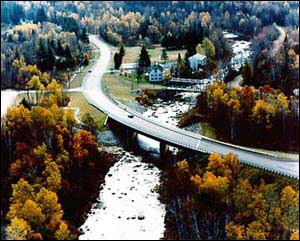















Successes in Stewardship: May 2003 |
|---|

|
Federal Highway Administration
May 2003
Questions and Answers: FHWA's Interim Guidance on Indirect and Cumulative Impacts
State departments of transportation (DOTs) and the Federal Highway Administration (FHWA) analyze the direct, indirect, and cumulative impacts of their actions as part of the National Environmental Policy Act (NEPA) process. While FHWA and state DOTs are making progress in incorporating indirect and cumulative impact considerations into project decisionmaking, the complexity of these issues can pose challenges. To help state DOTs analyze indirect and cumulative impacts and streamline the NEPA process, FHWA released its "Interim Guidance: Questions and Answers Regarding Indirect and Cumulative Impact Considerations in the NEPA Process" in January 2003.
The interim guidance is FHWA's initial step in addressing current indirect and cumulative impacts policy, guidance, and training needs. FHWA's interim guidance focuses attention on the existing NEPA requirements specific to indirect and cumulative impacts. FHWA believes that thoroughly reviewing the reasonably foreseeable direct and indirect impacts of transportation actions and appropriately documenting other cumulative impacts on specific resources are essential to making informed project decisions and attaining FHWA's environmental streamlining and stewardship goals. In addition to developing the interim guidance, FHWA is now planning other related activities, such as the development of supplemental policy and guidance, the possible revision of the FHWA's 1992 "Position Paper: Secondary and Cumulative Impact Assessment in the Highway Project Development Process," the development of training, and the collection and dissemination of examples and best practices.

To download "Interim Guidance: Questions and Answers
Regarding Indirect and Cumulative Impact Considerations in the NEPA Process,"
visit: http://www.fhwa.dot.gov/environment/guidebook/qaimpact.asp
Definitions
Definitions are based on CEQ regulations 40 CFR § 1500 - 1508. |
Regulatory History of Indirect and Cumulative ImpactsUnder NEPA, project sponsors are required to identify and avoid, minimize, or compensate for direct project impacts. While the NEPA legislation does not mention indirect or cumulative impacts, the Council on Environmental Quality (CEQ) established Federal agency responsibility for identifying, analyzing, and documenting direct, indirect, and cumulative impacts in its "Regulations for Implementing the Procedural Provisions of the National Environmental Policy Act (40 CFR §§ 1500 - 1508)." CEQ regulations direct that the environmental consequences section of an Environmental Impact Statement or Environmental Assessment include a discussion of adverse impacts that cannot be avoided, including direct and indirect impacts. Other statutory and regulatory mandates include indirect and/or cumulative impact requirements, including the Endangered Species Act, Section 404 of the Clean Water Act, Section 106 of the National Historic Preservation Act, and Executive Order 12898 on Environmental Justice. |
Highlights from the Interim GuidanceThe interim guidance provides FHWA field offices, state DOTs, and other environmental practitioners with a variety of information, including:
FHWA/EPA Workshops on Methods for Evaluating Secondary and Cumulative Land Use Impacts.In February 2003, FHWA Headquarters and the New England Region (Region 1) of the U.S. Environmental Protection Agency co-sponsored one-day workshops on successful methods for evaluating the secondary and cumulative land use impacts of transportation projects. Workshops were held in Albany, New York, Hartford, Connecticut, and Boston, Massachusetts, and participants included representatives from state and Federal transportation and natural resource agencies, metropolitan planning organizations, non-profit organizations, local governments, universities, and private consulting firms. Participants reviewed the available methods for analyzing land use impacts of transportation projects, the guidelines for selecting methods, and a case study on the use of the Delphi Process, which utilizes expert panels. Methods discussed included comprehensive plans, qualitative techniques (including the Delphi Process), quantitative techniques, Geographic Information Systems (GIS) techniques, statistical methods, regional economic/demographic models, and land use models. More workshops may be held in the future due to their initial popularity. |
Contact InformationLamar Smith |
|
"Successes in Stewardship" is a Federal Highway Administration newsletter highlighting current environmental streamlining practices from around the country. To subscribe, contact Cassandra Allwell at (617) 494-3997 or allwell@volpe.dot.gov. |
